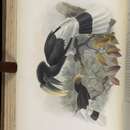Biology
provided by Arkive
Fruit makes up about 90 percent of the diet of the white-thighed hornbill, though it also takes insects and the eggs and nestlings of other birds (2) (3). Most feeding takes place high in the canopy, where large groups may gather at fruiting trees. The long distances travelled in search of fruit mean this hornbill is likely to be an important seed disperser, playing a key role in forest regeneration (2) (4) (6).
Hornbills have a unique form of nesting behaviour. The female uses mud or her own droppings to seal herself inside a tree cavity, leaving only a narrow slit through which the male feeds both her and the chicks until the time comes for the chicks to leave the nest (4). However, little else is known about the breeding behaviour of the white-thighed hornbill (2). Up to two nestlings have been recorded, but usually only a single offspring is seen flying with the parent birds after fledging (2) (3). Like other hornbills, the white-thighed hornbill is likely to be monogamous (4), and usually moves around in pairs or small family groups (2). There is no obvious breeding season (2), but reproduction may be timed to coincide with peak fruit availability and may even be abandoned in years when this is low (7).
Conservation
provided by Arkive
The white-thighed hornbill is not currently considered globally threatened, though population trends have yet to be quantified and there is some evidence that they are in decline (5). There are no known specific conservation measures in place for the species, but, as it is often treated together with B. cylindricus, further research may be needed to better understand the conservation needs of each as separate species.
Description
provided by Arkive
The white-thighed hornbill is a large and highly vocal bird, with a long, slightly decurved beak, topped with a large and distinctive growth known as a casque. The function of this strange structure is debated, though it may provide support for the long beak, help in attracting a mate, or serve to amplify the bird's raucous call (4).
The white-thighed hornbill is considered by some to be a subspecies of the brown-cheeked hornbill, Bycanistes cylindricus (2) (3) (5), although it occupies a distinct range (2) and differs in its colouration. Like B. cylindricus, the body is glossy black, and the rump, belly, tail coverts and tips of the wings are white, with a broad black band across the centre of an otherwise white tail. However, the white-thighed hornbill lacks the brown cheek and throat feathers of B. cylindricus, and has white on its thighs, giving the species its common name. Males have a brown beak, slightly grooved at the base of the lower mandible, with a cream-coloured tip, and a cream-coloured casque that also has slight grooving. The beak is darker and the casque more elongated than in B. cylindricus. The bare skin around the eye is pale yellow, the eye itself is brownish, and the legs and feet are black. Females are smaller, with much smaller beaks and casques, while juveniles lack the casque altogether (2) (3).
Habitat
provided by Arkive
The white-thighed hornbill is found in extensive areas of primary forest, mainly in lowlands, but also recorded up to elevations of 4,054 metres. It is also occasionally found in adjacent areas of secondary forest and in plantations (2) (3).
Range
provided by Arkive
Western and central Africa, from Benin east to Sudan and Uganda, and south to the Democratic Republic of the Congo and northern Angola (2) (3) (5).
Status
provided by Arkive
Classified as Least Concern (LC) on the IUCN Red List (1).
Threats
provided by Arkive
The white-thighed hornbill is threatened by habitat loss and fragmentation, and is among the first of the large hornbill species to be affected by forest disturbance, although it does sometimes occur in disturbed areas (2). Little information is available on whether, like other hornbill species (4), the white-thighed hornbill is hunted for food, as a pet or for body parts, such as for the 'ivory' of the casque, although it has been reported that some areas have local taboos against eating white-thighed hornbills (3).
White-thighed hornbill
provided by wikipedia EN
The white-thighed hornbill (Bycanistes albotibialis) is a species of hornbill. It is found in Angola, Benin, Cameroon, Central African Republic, Republic of the Congo, Democratic Republic of the Congo, Equatorial Guinea, Gabon, Nigeria, Sudan, and Uganda. It is sometimes considered to be a subspecies of the brown-cheeked hornbill.
References

- license
- cc-by-sa-3.0
- copyright
- Wikipedia authors and editors
White-thighed hornbill: Brief Summary
provided by wikipedia EN
The white-thighed hornbill (Bycanistes albotibialis) is a species of hornbill. It is found in Angola, Benin, Cameroon, Central African Republic, Republic of the Congo, Democratic Republic of the Congo, Equatorial Guinea, Gabon, Nigeria, Sudan, and Uganda. It is sometimes considered to be a subspecies of the brown-cheeked hornbill.
- license
- cc-by-sa-3.0
- copyright
- Wikipedia authors and editors

